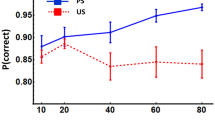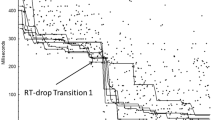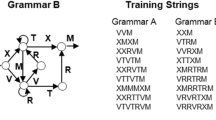Abstract
The serial reaction time (SRT) task is a commonly used paradigm to investigate implicit learning. In most studies the settings originally introduced by Nissen and Bullemer are replicated, i.e., subjects respond to a visuo-spatial sequence of stimulus locations by pressing spatially compatible arranged keys. The present experiment was designed to explore to what degree the sequential learning observed under these conditions depends on the use of locational sequences. Under otherwise identical conditions, first the S-R compatibility was reduced by using symbols instead of locations as stimuli, and second, the “connectibility,” i.e, the ease of connecting successive stimuli into coherent pattern, was varied. Effects on reaction times (RT) in the SRT task and on explicit memory in a generation task were evaluated. The results indicate that the connectibility of the stimuli has no effect at all and that S-R compatibility influences only the general RT level but does not seem to modify the learning process itself. Thus, the data are more consistent with the notion that learning is based primarily on the sequence of responses rather than on the sequence of stimuli. Moreover, a post hoc classification of subjects with regard to the amount of explicit sequence knowledge they have acquired reveals a striking modification of the general result: The RT difference between responses to locations and symbols vanishes in the course of learning for the complete explicit knowledge group. In order to account for this effect, we presume that the response control of these subjects shifts from stimuli to motor programs, so that RTs become increasingly independent of the stimuli used.
Similar content being viewed by others
References
Baddeley, A. (1986). Working Memory. Oxford: Claredon Press.
Berry, D. C., & Dienes, Z. (1993). Implicit learning: Theoretical and empirical issues. Hove: Erlbaum.
Buchner, A. (1993). Implizites Lernen: Probleme and Perspektiven [Implicit learning: Problems and perspectives]. Weinheim: Psychologie Verlags Union.
Cleeremans, A. (1993). Mechanisms of implicit learning: Connectionist models of sequence processing. Cambridge, MA: MIT Press.
Cleeremans, A., & McClelland, J. L. (1991). Learning the structure of event sequences. Journal of Experimental Psychology: General, 120, 235–253.
Cohen, A., Ivry, R., & Keele, S. W. (1990). Attention and structure in sequence learning. Journal of Experimental Psychology: Learning, Memory, and Cognition, 16, 17–30.
Cohen, J. (1988). Statistical power analysis for the behavioral sciences (2nd ed.). Hillsdale: Lawrence Erlbaum.
Collard, R., & Povel, D. (1982). Theory of serial pattern production: Tree traversals. Psychological Review, 89, 693–707.
Curran, T., & Keele, S. W. (1993). Attentional and non-attentional forms of sequence learning. Journal of Experimental Psychology: Learning, Memory, and Cognition, 19, 189–202.
Dulany, D. E., Carlson, R. A., & Dewey, G. I. (1984). A case of syntactical learning and judgement: How conscious and how abstract? Journal of Experimental Psychology: General, 113, 541–555.
Eimer, M., Hommel, B., & Prinz, W. (1995). S-R compatibility and response selection. Acta Psychologica, 90, 301–313.
Farah, M. J., Levine, D. N., & Calvanio, R. (1988). A case study of mental imagery deficit. Brain & Cognition, 8, 147–164.
Fendrich, D. W., Healy, A. F., & Bourne, L. E. (1991). Long-term representation effects for motoric and perceptual procedures. Journal of Experimental Psychology: Learning, Memory, and Cognition, 17, 137–151.
Frensch, P. A., & Miner, C. S. (1994). Effects of presentation rate and individual differences in short-term memory capacity on an indirect measure of serial learning. Memory and Cognition, 22, 95–110.
Frensch, P. A., & Miner, C. S. (1995). Zur Rolle des Arbeitsgedäch-tnisses beim impliziten Sequenzlernen [The role of working memory in implicit sequence learning]. Zeitschrift für Experimén-telle Psychologie, 42, 545–575.
Frensch, P. A., Buchner, A., & Lin, J. (1994). Implicit learning of unique and ambiguous serial transitions in the presence and absence of a distracter task. Journal of Experimental Psychology: Learning, Memory, and Cognition, 20, 567–584.
Hanley, J. R., Young, A. W., & Pearson, N. A. (1991). Impairment of the visuo-spatial sketch pad. The Quarterly Journal of Experimental Psychology, 43A, 101–125.
Hartman, M., Knopman, D. S., & Nissen, M. J. (1989). Implicit learning of new verbal associations. Journal of Experimental Psychology: Learning, Memory, and Cognition, 15, 1070–1082.
Hoffmann, J. (1993). Unbewußtes Lernen — eine besondere Lernform? [Unconscious learning — a special kind of learning?]. Psychologische Rundschau, 44, 75–89.
Hoffmann, J., & Koch, I. (1996). Implicit learning of loosely defined structures. In M. Stadler & P. A. Frensch (Eds.), Handbook of implicit learning, Thousands Oaks, CA: Sage Publications.
Hoffmann, J., & Sebald, A. (1996). Reiz- und Reaktionsmuster in seriellen Wahlreaktionen [Stimulus and response patterns in serial choice reactions]. Zeitschrift für experimentelle Psychologie, XLIII, 40–68.
Howard, J. H., Mutter, S. A., & Howard, D. V. (1992). Serial pattern learning by event observation. Journal of Experimental Psychology: Learning, Memory, and Cognition, 18, 1029–1039.
Keele, S. W. (1968). Movement control in skilled motor performance. Psychological Bulletin, 70, 387–403.
Keele, S. W., & Jennings, P. J. (1992). Attention in the representation of sequence: Experiment and theory. Human Movement Science, 11, 125–138.
Keele, S. W., Jennings, P., Jones, S., Caulton, D., & Cohen, A. (1995). On the modularity of sequence representation. Journal of Motor Behavior, 27, 17–30.
Lewicki, P. (1986). Processing information about covariation that cannot be articulated. Journal of Experimental Psychology: Learning, Memory, and Cognition, 12, 135–146.
Lewicki, P., Hill, T., & Sasaki, I. (1989). Self-perpetuating development of encoding biases. Journal of Experimental Psychology: General, 118, 323–337.
Logie, R. H. (1995). Visuo-spatial working memory. Hillsdale: Erlbaum.
Mayr, U. (1996). Spatial attention and implicit sequence learning: Evidence for independent learning of spatial and nonspatial sequences. Journal of Experimental Psychology: Learning, Memory, and Cognition, 22, 350–364.
Nattkemper, D., & Prinz, W. (1993). Processing structured event sequences. In C. Bundesen & A. Larsen (Eds.), Proceedings of the sixth conference of the European Society for Cognitive Psychology (pp. 21–22). Copenhagen: ESOP.
Nissen, M. J., & Bullemer, P. (1987). Attentional requirements of learning: Evidence from performance measures. Cognitive Psychology, 19, 1–32.
Perruchet, P., & Amorim, M. A. (1992). Conscious knowledge and changes in performance in sequence learning: Evidence against dissociation. Journal of Experimental Psychology: Learning, Memory, and Cognition, 18, 785–800.
Perruchet, P., & Gallego, J. (1993). Association between conscious knowledge and performance in normal subjects: Reply to Cohen and Curran (1993) and Willingham, Greeley, and Bardone Journal of Experimental Psychology: Learning, Memory, and Cognition, 19, 1438–1444.
Perruchet, P., & Pacteau, C. (1990). Synthetic grammar learning: Implicit rule abstraction or explicit fragmentary knowledge. Journal of Experimental Psychology: General, 119, 264–275.
Posner, M. I. (1992). Attention as a cognitive and neural system. Psychological Science, 1, 11–14.
Posner, M. I., & Rothbart, M. (1992). Attentional mechanisms and conscious experience. In A. D. Milner and M.D. Rugg (Eds.), The neuropsychology of consciousness (pp. 91–111). San Diego, CA: Academic Press.
Povel, D. J., & Collard, R. (1982). Structural factors in patterned finger tapping. Acta Psychologica, 52, 107–124.
Reber, A. S. (1967). Implicit learning of artificial grammars. Journal of Verbal Learning and Verbal Behavior, 6, 855–863.
Reber, A. S. (1976). Implicit learning of synthetic languages: The role of instructional set. Journal of Experimental Psychology: Human Learning and Memory, 2, 88–94.
Reber, A. S. (1989). Implicit learning and tacit knowledge. Journal of Experimental Psychology: General, 118, 219–235.
Reber, A. S. (1993). Implicit learning and tacit knowledge. An essay on the cognitive unconscious. New York: Oxford University Press.
Reber, A. S., & Allen, R. (1978). Analogic and abstraction strategies in synthetic grammar learning: A functionalist interpretation. Cognition, 6, 189–221.
Reed, J., & Johnson, P. (1994). Assessing implicit learning with indirect tests: Determining what is learned about sequence structure. Journal of Experimental Psychology: Learning, Memory, and Cognition, 20, 585–594.
Restle, F. (1970). Theory of serial pattern learing: Structural trees. Psychological Review, 77, 481–495.
Rosenbaum, D. A., Kenny, S. B., & Derr, M.A. (1983). Hierarchical control of rapid movement sequences. Journal of Experimental Psychology: Human Perception and Performance, 9, 86–102.
Salway, A. F. S., & Logie, R. H. (1995). Visuo-spatial working memory, movement control and executive demands. British Journal of Psychology, 86, 253–269.
Seger, C. A. (1994). Implicit learning. Psychological Bulletin, 115, 163–196.
Shanks, D. R., & St John, M. F. (1994). Characteristics of dissociable learning systems. Behavioral and Brain Sciences, 17, 367–395.
Simon, J. R. (1969). Reactions toward the source of stimulation. Journal of Experimental Psychology, 81, 174–176.
Simon, J. R., & Rudell, A. P. (1967). Auditory S-R compatibility: The effect of an irrelevant cue on information processing. Journal of Applied Psychology, 51, 300–304.
Smyth, M. M., & Scholey, K. A. (1994). Interference in immediate spatial memory. Memory & Cognition, 22, 1–13.
Smyth, M. M., Pearson, N. A., & Pendleton, L. R. (1988). Movement and working memory: Patterns and positions in space. The Quarterly Journal of Experimental Psychology, 40A, 497–514.
Stadler, M. A. (1989). On learning complex procedural knowledge. Journal of Experimental Psychology: Learning, Memory, and Cognition, 15, 1061–1069.
Stadler, M. A. (1992). Statistical structure and implicit serial learning. Journal of Experimental Psychology: Learning, Memory, and Cognition, 18, 318–327.
Stadler, M. A. (1993). Implicit serial learning: Questions inspired by Hebb (1961). Memory and Cognition, 21, 819–827.
Stadler, M. A. (1995). Role of attention in implicit learning. Journal of Experimental Psychology: Learning, Memory, and Cognition, 21, 674–685.
Ungerleider, L. G., & Mishkin, M. (1982). Two cortical visual systems. In D. J. Ingle & R. J. W. Mansfield (Eds.), Analysis of visual behavior (pp. 549–586). Cambridge, Mass.: MIT Press.
Willingham, D. B., Nissen, M. J., & Bullemer, P. (1989). On the development of procedural knowledge. Journal of Experimental Psychology: Learning, Memory, and Cognition, 15, 1047–1060.
Ziessler, M. (1994). The impact of motor responses on serial learning. Psychological Research, 57, 30–41.
Ziessler, M. (1995). Die Einheit von Wahrnehmung und Motorik [The unity of perception and motor behavior]. Frankfurt am Main: Peter Lang.
Ziessler, M., Hänel, K., & Hoffmann, J. (1988). Die Programmierung struktureller Eigenschaften von Bewegungsfolgen [The programming of structural properties of movement sequences]. Zeitschrift für Psychologie, 196, 371–388.
Ziessler, M., Hänel, K., & Sachse, D. (1990). The programming of structural properties of movement sequences. Psychological Research, 52, 347–358.
Author information
Authors and Affiliations
Corresponding author
Rights and permissions
About this article
Cite this article
Hoffmann, J., Koch, I. Stimulus-response compatibility and sequential learning in the serial reaction time task. Psychol. Res 60, 87–97 (1997). https://doi.org/10.1007/BF00419682
Received:
Accepted:
Issue Date:
DOI: https://doi.org/10.1007/BF00419682




